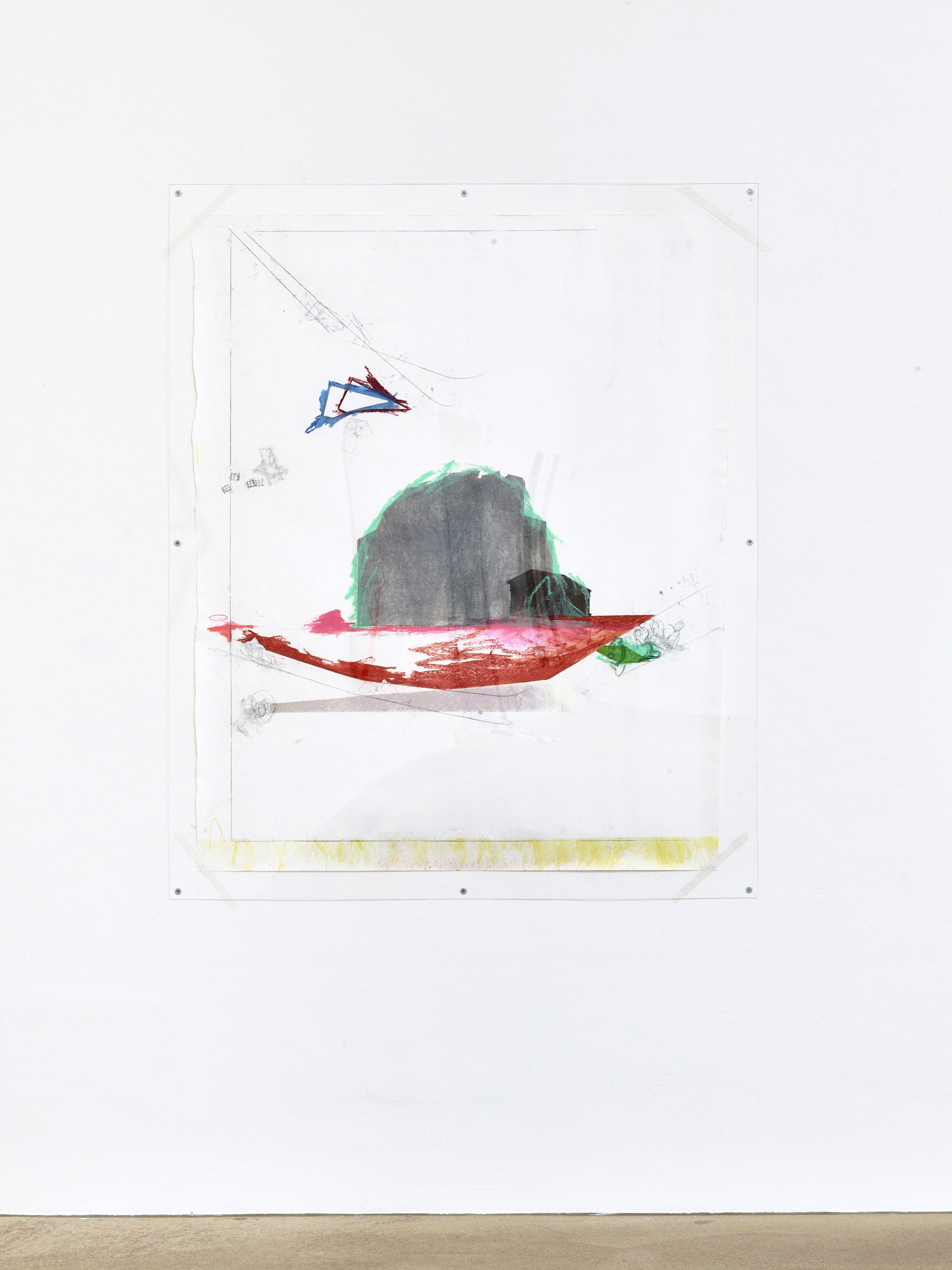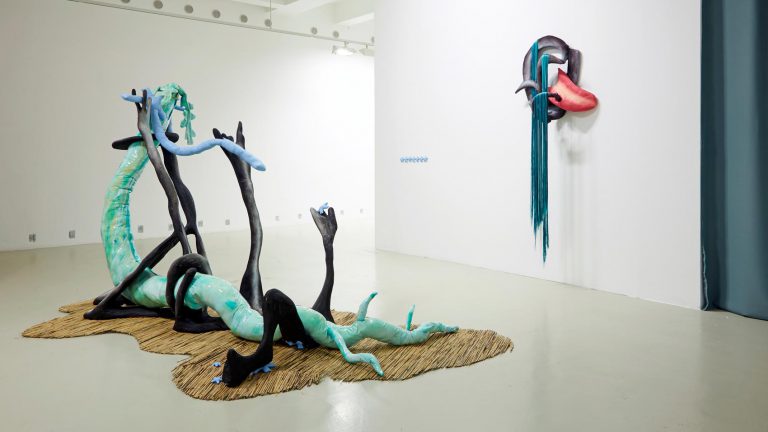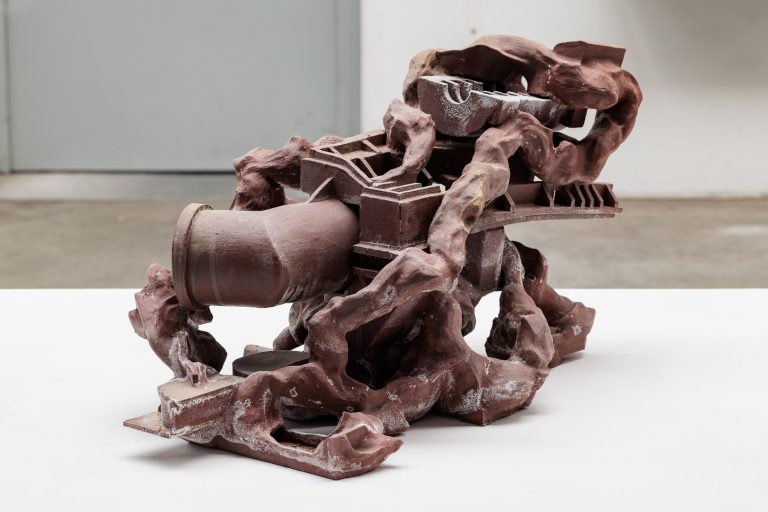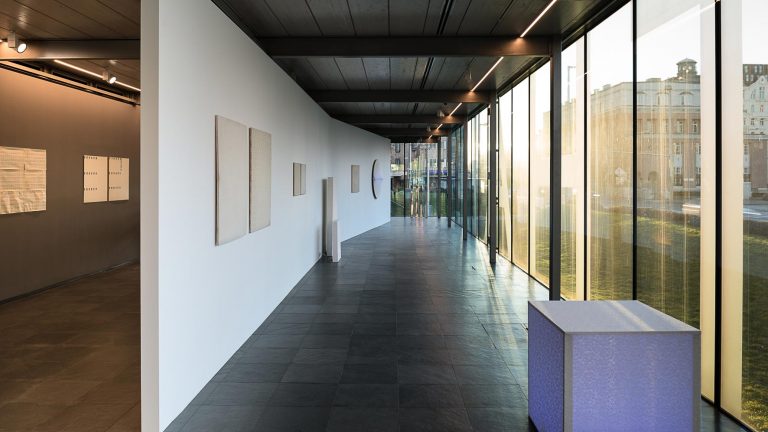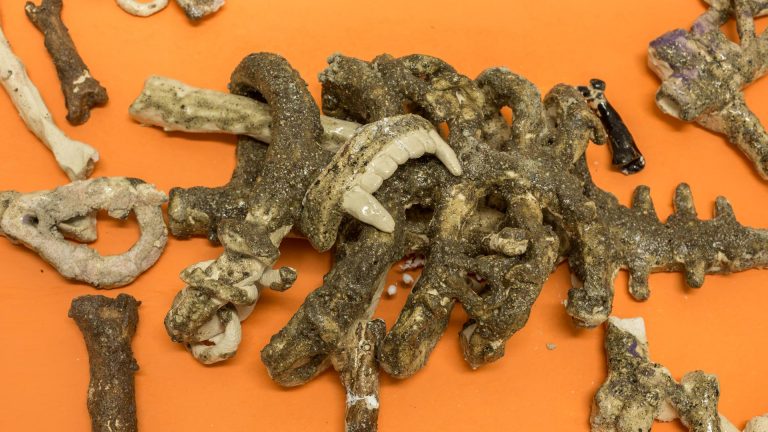Artists: Imre Bak, Sári Ember, János Fajó, Andreas Fogarasi, Péter Tamás Halász, György Jovánovics, Tamás Kaszás, Zsófia Keresztes, Ilona Keserü Ilona, Adrian Kiss, Ádám Kokesch, Tamás Komoróczky, László Lakner, Little Warsaw, Mira Dalma Makai, Dóra Maurer, István Nádler, Márton Nemes, Péter Puklus, Klára Rudas, Gergő Szinyova, Zsolt Tibor, Ádám Ulbert, Júlia Vécsei
Exhibition title: Abstract Hungary
Curated by: Sandro Droschl, Áron Fenyvesi
Venue: Künstlerhaus Halle für Kunst & Medien, Graz, Austria
Date: June 24 – September 9, 2017
Photography: all images copyright and courtesy of the artists and Künstlerhaus Halle für Kunst & Medien
With “Abstract Hungary” the Künstlerhaus, Halle für Kunst & Medien (KM– Graz) is presenting twenty-four Hungarian artists of different generations whose artistic practice is devoted to current variations of abstract art. The exhibition represents a further development of the narrative blueprint for the much-discussed concept of abstraction. It will feature both established and new artists, some of whom are exhibiting their work for the first time in Austria. On two floors indoors and in a sculpture in public space, art by younger and middle generations enter into a dialogue with pioneers from the 1960s whose oeuvres have remained relevant to the present-day production of art.
Internationally known key figures such as László Moholy-Nagy, Victor Vasarely, Simon Hantaï, and Lajos Kassák make us aware that abstract art in Hungary has a long and complicated history that has continued to develop throughout the twentieth and early twenty-first centuries. For a long time, abstract art was regarded as a practice that received no special recognition.
Contemporary abstract art is inspired by a critical approach to the supposed universality of a visual vocabulary, which, among other things, can be perceived as a kind of universal art relieved of the burden of local context. In Hungary today abstract artists strive for a timeless, enduring perspective of art that is rooted in the knowledge of its long history. The younger generation’s lively, relatively instinctual works tend to distance themselves from a minimalist approach as they open up to a variety of directions from trash aesthetics to the boundaries of figurative art. Taken altogether, it’s possible to discern in them a reflective stance toward the current wave of international attention focused on abstract art.
The term “abstract” plays an overriding role in the show, in the sense that it represents an open-minded, productive attitude that transcends the ostensible practice of formalism. The term also encompasses an art historical, discursive dimension that sheds some critical light on the factor of time, while also regarding the participating artists as a connective element. In a period of ambivalent political, social, economic, and technological spheres, abstract art interprets things beyond the local. This approach plays with the concept of an independent international language, underscoring its strength as a binding element that surpasses language barriers. To this extent, the exhibition is not about representing the country. Rather, it takes today’s complicated and confusing local and international environments as its starting point in order to contrast via proposals and drafts—“abstracts” with future potential—updated and living traditions with a stance that overcomes the classic idea of the nation. Moving beyond the specific interest in the Hungarian art scene, the exhibition’s title could also be interpreted as an interchangeable, “abstract” concept, in the sense that it represents a productive, empty space for potential contemporary international developments in art and society. Ultimately, the title also brings into question the concept of “abstract art,” a term that is overburdened with art historical weight; at best it could be made productive again, as an effective structural aspect of the chain of arguments alluded to here.
The thematic exhibition emphasizes the diverse approaches and understandings of abstract art, from the instinctive and conceptual ideas to the referential and perspectival ones. Without wanting to create an overview with the aid of lexical, chronological, or taxonomic methods, the exhibition demonstrates the complexities of abstract art, which range from the radical geometrical references of the 1960s to the coherent development that continues to this day, despite all of the interruptions and variations.
The Künstlerhaus has invited numerous artists who carry on the legacy of the quiet modernism of abstract art—the neo-avant-garde that was established in the late 1960s. Other important artists in the show represent Neo-Conceptualism, a movement from the 1990s. The youngest generation of Hungarian artists, born in the 1980s and 1990s, are part of the local dialogue and shed new light on current directions in abstract art—most certainly influenced by the conceptual inclusion of the global discourse.
The exhibition “Abstract Hungary” encompasses painting, sculpture, installations, ceramics, photography, and video. The show also incorporates a sculptural and performative intervention in the public space that refers to the historical concepts of Lajos Kassák. This installation will function as both a site for performances and workshops, as well as a meeting point for passersby in the city park, who will be able to use this public space as a stage for their own individual purposes.
Exhibiton view with the works of János Fajó. Abstract Hungary, 2017, Künstlerhaus, Halle für Kunst & Medien, Graz. photo: Pascal Petignat
Exhibiton view with the works of Gergő Szinyova (left), Ádám Kokesch (middle) and Imre Bak (right). Abstract Hungary, 2017, Künstlerhaus, Halle für Kunst & Medien, Graz. photo: Pascal Petignat
Gergö Szinyova: AABCIEOC1552017, AABCIEOC1752017 and AABCIEOC1952017. Each 195 × 130 cm. Acrylic, airbrush, Chinese ink, enamel, oil on canvas, 2017. Exhibiton view, Abstract Hungary, 2017, Künstlerhaus, Halle für Kunst & Medien, Graz. photo: Pascal Petignat
Gergö Szinyova: AABCIEOC1552017. 195 × 130 cm. Acrylic, airbrush, Chinese ink, enamel, oil on canvas, 2017. photo: Pascal Petignat
Exhibiton view with the Ádám Kokesch (front): Untitled, Acrylic, plexiglass, wood, neon tube, stand, electronic devices, 2013-2015, and Imre Bak (back): Mégis, Acrylic on canvas, 140 × 210 cm, 2014. Abstract Hungary, 2017, Künstlerhaus, Halle für Kunst & Medien, Graz. photo: Pascal Petignat
Exhibiton view, Abstract Hungary, 2017, Künstlerhaus, Halle für Kunst & Medien, Graz. photo: Pascal Petignat
Exhibition view with László Lakner: Untitled. 200 × 150 cm. Oil on canvas, 1990. and Untitled. 200 × 150 cm. Oil on canvas, 2017. Abstract Hungary, 2017, Künstlerhaus, Halle für Kunst & Medien, Graz. photo: Pascal Petignat
László Lakner: Untitled. 200 × 150 cm. Oil on canvas, 2017. photo: Pascal Petignat
Exhibiton view with Júlia Vécsei (foreground): Playground, 10 iron objects, each 55 × 27 × 22 cm, 2013 and István Nádler (background): No. 7., Acrylic on canvas, 200 × 150 cm, 2014 and No. 11., Acrylic on canvas, 200 × 150 cm, 2014. Abstract Hungary, 2017, Künstlerhaus, Halle für Kunst & Medien, Graz. photo: Pascal Petignat
Exhibiton view with Andreas Fogarasi: Vasarely Go Home, two-channel video installation with c-prints and objects, 2011. Abstract Hungary, 2017, Künstlerhaus, Halle für Kunst & Medien, Graz. photo: Pascal Petignat
Dóra Maurer: Overlappings 47. Acrylic on canvas, wood, 117 × 124 cm, 2012. photo: Pascal Petignat
Zsófia Keresztes: From a Trustworthy Source. Acrylic, iPhone boxes, Styrofoam, thread, 123 × 60 × 5 cm, 2016. Exhibiton view, Abstract Hungary, 2017, Künstlerhaus, Halle für Kunst & Medien, Graz. photo: Pascal Petignat
Exhibiton view with the works of Sári Ember, papercollages, c-print, marble object, silk, iron, aluminium, 2016-2017. Abstract Hungary, 2017, Künstlerhaus, Halle für Kunst & Medien, Graz. photo: Pascal Petignat
Exhibiton view with the series of Ádám Ulbert entitled Toad Edifice / Phantom Senses. Pencil, polyurethane, watercolor, epoxy, rubber, steel, animation, 2016. Abstract Hungary, 2017, Künstlerhaus, Halle für Kunst & Medien, Graz. photo: Pascal Petignat
Ádám Ulbert: Toad Edifice / Phantom Senses 2 and 3. Pencil, polyurethane, watercolor, each 21 × 30 cm, 2016. photo: Pascal Petignat
Exhibition view with Zsolt Tibor: secret frog architecture. Graphite and chalk on paper, 156x126cm, 2016 and domesticity haiku II, Acrylic, graphite, gouache on paper, 152 × 136 cm, 2016. Abstract Hungary, 2017, Künstlerhaus, Halle für Kunst & Medien, Graz. photo: Pascal Petignat
Zsolt Tibor: secret frog architecture. Graphite and chalk on paper, 156x126cm, 2016. photo: Pascal Petignat
Exhibiton view with the works of Márton Nemes (left) and György Jovánovics (right). Abstract Hungary, 2017, Künstlerhaus, Halle für Kunst & Medien, Graz. photo: Pascal Petignat
György Jovánovics: P.A.K.S. 1. Plaster, 140 × 100 cm, 2004. photo: Pascal Petignat
Exhibition view of Adrian Kiss: Sylvania, Concrete blocks, fluorescent lights, laminated wood on metal structure, 400 × 340 × 260 cm, 2013. Abstract Hungary, 2017, Künstlerhaus, Halle für Kunst & Medien, Graz. photo: Pascal Petignat
Exhibition view with the works Mira Dalma Makai, glazed ceramic, litographs, 2017. Abstract Hungary, 2017, Künstlerhaus, Halle für Kunst & Medien, Graz. photo: Pascal Petignat
Tamás Komoróczky: Gegenstand ed Wesen (Objet es essence), Burnt clay, glazed ceramic, mirrored plexiglass, stainless steel, plate, telephone cable, wood, 2017. Exhibiton view, Abstract Hungary, 2017, Künstlerhaus, Halle für Kunst & Medien, Graz. photo: Pascal Petignat
Exhibition view with Tamás Komoróczky: A History of the World in 100 Objects – The New Ozymandias, HD video, sound, 14 min, 2016. Abstract Hungary, 2017, Künstlerhaus, Halle für Kunst & Medien, Graz. photo: Pascal Petignat
Exhibiton view with Ádám Ulbert’s Nostalgia, Video, 5:31 min., color, sound, 2013. Abstract Hungary, 2017, Künstlerhaus, Halle für Kunst & Medien, Graz. photo: Pascal Petignat
Márton Nemes: TemporaryImages01, Acrylic, cargo strap, Molino canvas, offset print, wood, 127 × 97 cm, 2017. photo: Pascal Petignat
Márton Nemes: TemporaryImages02, Acrylic, cargo strap, Molino canvas, offset print, wood, 127 × 102 cm, 2017. photo: Pascal Petignat
Exhibition view with Klára Rudas’ untitled works, oil on paper, 2016-2017. Abstract Hungary, 2017, Künstlerhaus, Halle für Kunst & Medien, Graz. photo: Pascal Petignat
Exhibition view with Péter Puklus’ The Epic Love Story of a Warrior, Analog prints on color paper; processed with ReAnalog negative, wooden sculpture, 2011-2015. Abstract Hungary, 2017, Künstlerhaus, Halle für Kunst & Medien, Graz. photo: Pascal Petignat
Exhibiton view with Péter Puklus: Monument (Black), Wooden sculpture, 13 × 13 × 40 cm, 2015
Exhibiton view with Péter Puklus (center) : Maquette of a Monument Symbolizing the Liberation IV., Ilona Keserü Ilona (left): Cangiante Voices and Zsófia Keresztes (right): Empty Reliquary. Abstract Hungary, 2017, Künstlerhaus, Halle für Kunst & Medien, Graz. photo: Pascal Petignat
Tamás Kaszás: Stage Monument. Wood, plexiglass, 500 × 700 × 350 cm, 2017. Exhibition view Abstract Hungary, 2017, Künstlerhaus, Halle für Kunst & Medien, Graz. photo: Pascal Petignat

















